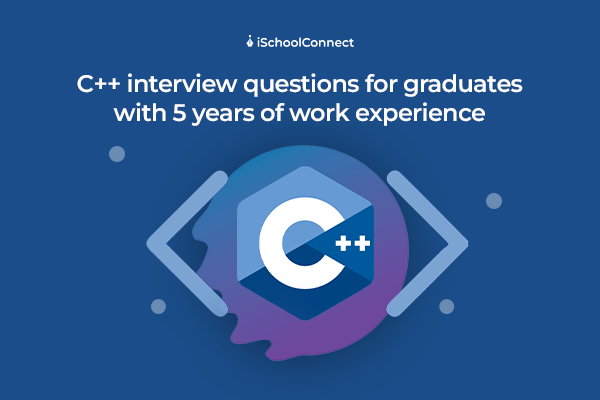Table of Contents
- Define friend function
- What is a virtual function?
- What is the difference between an array and a list?
- What do you mean by a move constructor?
- What is polymorphism in C++?
- What do you mean by call by value and call by reference?
- What is a class?
- Explain what is data abstraction in C++?
- Define encapsulation in C++?
- What is an abstraction in C++?
- What we have to say
- FAQ’s
Any company’s or organization’s selection procedure includes an interview. To face the interviewer, you must be well prepared for the questions. Check out this blog to know how to answer the most frequently asked C++ interview questions for experienced professionals.
Define friend function
The Friend function operates as a class friend. It has access to the class’s private and protected members. Although the friend function is not a class member, it must be specified in the class definition. The non-member function has no access to the class’s secret data. Sometimes the non-member function needs to access the data. The friend function is a non-member function that has access to the class’s private information.
What is a virtual function?

A virtual function is utilized when there is a need to replace the implementation given by the base class. Even if the object is accessible via a base pointer rather than a derived pointer, the replacement is always called whenever the item in question is in the derived class.
A virtual function is a member function that is specified by the derived class but exists in the base class.
When the same function name is used in both the base and derived classes, the base class function is defined with the term virtual.
When a function is made virtual, C++ uses the type of the object referenced by the base class pointer to determine which function should be called at runtime, thereby creating the basic class
What is the difference between an array and a list?
Distinguishing among the important aspects of this front also proves to be one of the most frequently asked C++ interview questions for experienced professionals.
A list is made up of heterogeneous elements, whereas an array is made up of homogenous components.
Memory allocation in an array is static and continuous, but memory allocation in a list is dynamic and unpredictable. Users of an array do not need to keep track of the next memory allocation, but users of a list must keep track of the next memory allocation location.
What do you mean by a move constructor?
A Move Constructor and a move assignment operator are two new features in C++11. It is known that a copy constructor and copy assignment are used to copy an object to another, but the move constructor and move assignment are used to transfer resource ownership from one object to another.
This is less costly than copying one object to another object. The compiler does not supply a move constructor or move assignment operator by default, thus it must be implemented.
What is polymorphism in C++?
Polymorphism is defined as the presence of several forms. Its behavior varies depending on the scenario. This happens when numerous classes are connected through inheritance.
There are two forms of polymorphism in C++:
- Time Polymorphism Compilation
- Polymorphism at Runtime
What do you mean by call by value and call by reference?
Distinguishing between concepts such as these is one of the most frequently asked C++ interview questions for experienced professionals.
We transmit a copy of the parameter to the functions when using the call-by-value approach. A new memory is assigned to these duplicated values, and changes to these values do not affect the variable in the main function.
We supply the address of the variable to the call by reference technique, and the address is utilized to retrieve the actual argument used in the function call. As a result, changes to a parameter affect the passing argument.
What is a class?

A user-defined data type is a class. The data members and member functions are contained in the class, and their access is controlled by the three modifiers: private, public, and protected. It defines a data type, but not the data; rather, it specifies the data structure.
A class can produce an unlimited number of objects.
Explain what is data abstraction in C++?
Data abstraction is a method of presenting vital information to the outer world while concealing background elements.
Define encapsulation in C++?
Encapsulation is the process of tying a class’s data and functions together. For security concerns, it is used to limit direct access to data. This is when a class’s functions come in handy. For example, only the authorized individual with the proper login ID and password may use the customers’ net banking facility.
What is an abstraction in C++?
In C++, an abstraction hides the internal implementations and just shows the necessary information. When sending a critical message by email, simply writing and selecting the send option is implemented. This is just a message that showcases that your email has been delivered. However, the procedure of transmitting data by email is of no benefit if it is not visible.
What we have to say
- It is important to be clear and thorough about all the C++ interview questions for experienced professionals.
- The interviewer could also be interested in the interviewee’s attitude and mannerisms. Hence, it is not only important to be right but also to answer precisely, which makes it easy for your answer to stand out.
Liked the blog? Comment below and share your thoughts with us!
Liked this blog? Read next: IT engineer | All you need to know to become a successful one
FAQ’s
Q1. What are the types of member functions?
Answer –
- Simple functions
- Static functions
- Const functions
- Inline functions
- Friend functions
Q2. Explain what a pointer is
Answer – The pointer is used to hold the address of the current object
Q3. What does a scope resolution operator do?
Answer – The scope resolution operator (::) is used to define the member function outside the class.






